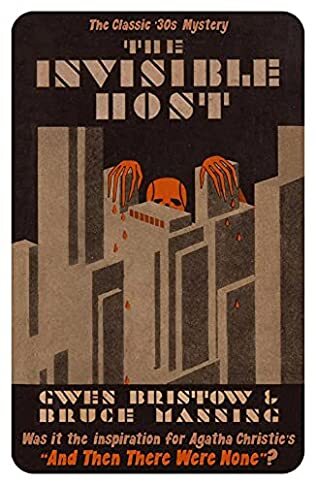The Invisible Host

A review of The Invisible Host by Gwen Bristow and Bruce Manning
This was the first collaboration between American husband-and-wife duo, Bruce Manning and Gwen Bristow, and was originally published in 1930. They collaborated on two further novels. It has now been reissued by Dean Street Press and they were kind enough to send me a review copy. Many thanks. It spawned, pre-publication, a play on Broadway called The Ninth Guest by Owen Davis, which ran between August and October 1930, and a film of the same name which was released by Columbia in 1934.
It is more of a psychological thriller than a straightforward murder mystery, although there is an element of whodunit about it, and it is heavy on atmosphere. Eight individuals, in their own ways pillars of New Orleans society, receive a telegram inviting them to a surprise party in their honour at the Bienville penthouse. To ensure their attendance the telegram promises them the most original party ever staged in New Orleans. To add to the intrigue, the sender just signs themselves as Your Host.
The recipients, in alphabetical order, are Henry Abbott, a professor, Margaret Chisholm, a socialite, Peter Daly, a playwright, Sylvia Inglesby, a lawyer, Jason Osgood, a businessman, Dr Murray Chmabers Reid, a university professor, Tim Slamon, a politician, and Jean Trent, an actress. All think so much of themselves that they take the bait and each is surprised to find the other invitees at the party which they thought was in their honour. As the guest wonder who their host is, it emerges that that the guests have been carefully chosen so that there is at least one other person in the room whom they dislike. This ramps up the dramatic tension.
The host communicates with them via a wireless set – we later find out that it was transmitting messages pre-recorded on a series of records – and tells them that they are to participate in a game of wits with their host, the forfeit for failure being their own death. There are eight empty coffins outside on the patio to reinforce the message. There is no means of escape as the door has an electric current running through it.
One by one, starting with the one who most deserves to die, they meet their death and the tension and feeling of foreboding increases. The murderer makes a fatal error which leads to their undoing when just three of the guests remain. I will not spoil your enjoyment by revealing their identity or motivation, the former the attentive reader of the book will spot although the motivation is only revealed at the end. That is a structural problem with a story that relies on the masking of the identity of the culprit and with so many possible suspects.
The plot may sound familiar, and it is, used by Agatha Christie in her 1939 classic, Ten Little Indians aka Then There Were None. While it is lauded as one of Christie’s best, it is so similar to The Invisible Host as to invite allegations of plagiarism, conscious or otherwise. In truth, Christie takes the idea to a higher level. The characterisation of the guests in The Invisible Host is much weaker, less time is taken to introduce them to the reader and their foibles, which are key to their demise, only emerge during the denouement.
For all that, it is a thoroughly enjoyable journey into the depths of the human psyche and an exploration of how the victim’s narcissism can play into the hands of someone fuelled by a sense of injustice and a determination to wreak vengeance. It is dark and disturbing at the same time as being entertaining, a neat trick to pull off. Dean Street Press are to be congratulated for rescuing this minor classic from the vaults of obscurity. It might even prompt a reassessment of Agatha Christie. Now would that not be a fine achievement, to knock her off her perch!



